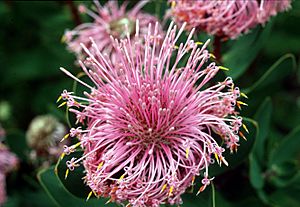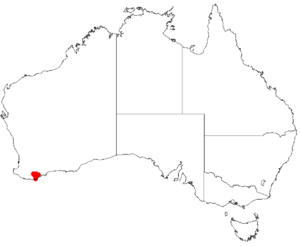Isopogon latifolius facts for kids
Quick facts for kids Isopogon latifolius |
|
|---|---|
 |
|
| Conservation status | |
| Scientific classification | |
| Genus: |
Isopogon
|
| Species: |
latifolius
|
 |
|
| Occurrence data from Australasian Virtual Herbarium | |
| Synonyms | |
|
Atylus latifolius (R.Br.) Kuntze |
|
Isopogon latifolius is a special kind of shrub that belongs to the Proteaceae plant family. It only grows naturally in the southwest part of Western Australia. This means it is endemic to that area, found nowhere else in the world.
Contents
What Does It Look Like?
Isopogon latifolius is a woody shrub that stands tall, growing up to 3 meters (about 10 feet) high. The new parts of the plant have tiny hairs.
Its thick leaves are narrow and can be 4 to 14 centimeters long. They are shaped like an oval or wider at the top, and they feel smooth. You might see faint lines on them, and each leaf ends in a sharp point.
This plant blooms between September and December. Its flowers are a beautiful pink and grow in large, showy heads. These flower heads, called inflorescences, appear at the ends of the branches, sitting above the leaves. They can be as wide as 8 centimeters across.
How It Got Its Name
The plant was first officially described in 1830 by a botanist named Robert Brown. He studied plant samples collected by William Baxter near King George's Sound.
The name latifolius comes from two Latin words. Latus means "wide," and folium means "leaf." So, Isopogon latifolius basically means "Isopogon with wide leaves."
Where It Grows
Isopogon latifolius is found in Western Australia, from Albany and the Stirling Range all the way east to an area near Cheyne Bay.
It likes to grow on hilltops, rocky spots, and slopes. You can find it in places with sandstone, quartzite, or schist rocks. It often grows in areas with low bushes (heath), dense shrubs (scrub), or short woodlands.
Plant Survival and Threats
This plant is very sensitive to a disease called dieback, which is caused by a fungus-like organism named Phytophthora cinnamomi. This disease can kill the plant, putting it at risk of disappearing from the wild.
Isopogon latifolius also takes a long time to flower from a seed, sometimes more than five years. This means that if fires happen too often in its habitat, the plant might not have enough time to grow and produce new seeds before the next fire. This can cause it to disappear from certain areas.
Growing This Plant
Isopogon latifolius is known as one of the most beautiful Isopogon plants. People can grow it in places that are not too humid and where the soil drains water well. If these conditions are not met, the plant might not survive.
Gardeners have successfully joined parts of Isopogon latifolius onto another plant called Isopogon anethifolius. This plant is also used in the cut flower industry, meaning its beautiful flowers are picked and sold for bouquets.


